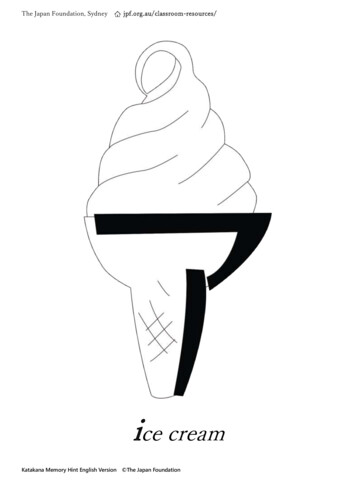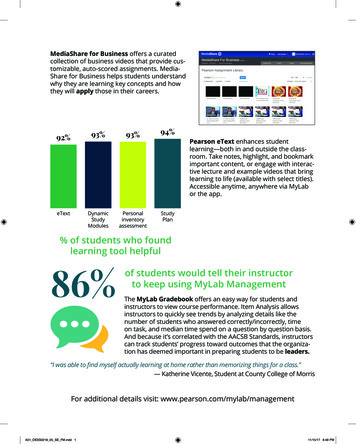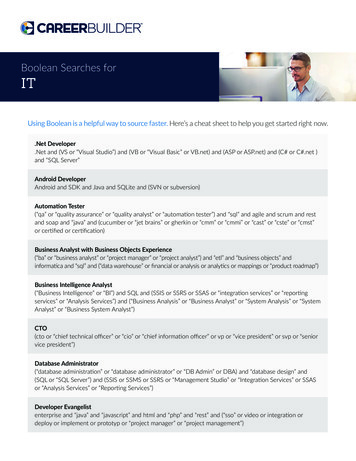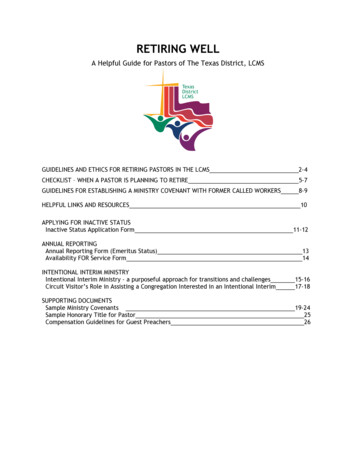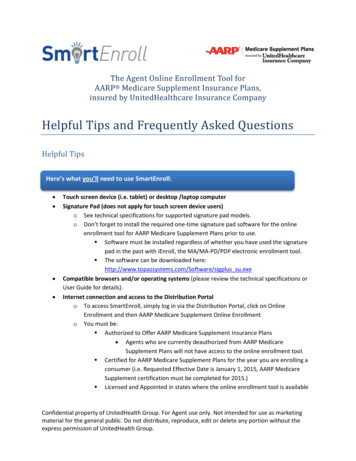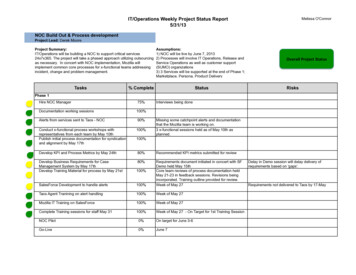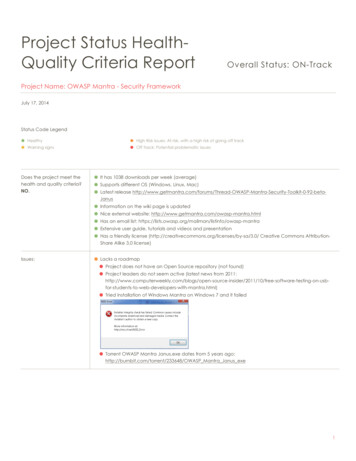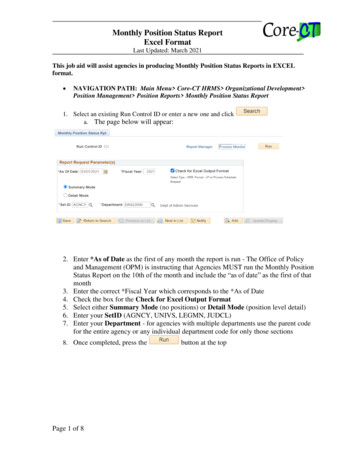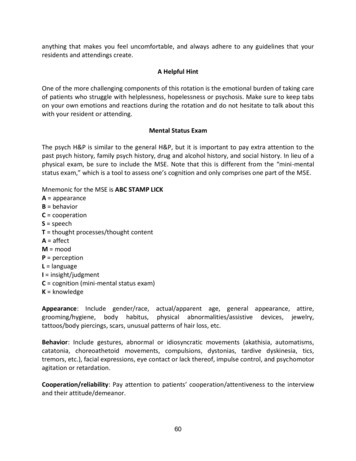
Transcription
anything that makes you feel uncomfortable, and always adhere to any guidelines that yourresidents and attendings create.A Helpful HintOne of the more challenging components of this rotation is the emotional burden of taking careof patients who struggle with helplessness, hopelessness or psychosis. Make sure to keep tabson your own emotions and reactions during the rotation and do not hesitate to talk about thiswith your resident or attending.Mental Status ExamThe psych H&P is similar to the general H&P, but it is important to pay extra attention to thepast psych history, family psych history, drug and alcohol history, and social history. In lieu of aphysical exam, be sure to include the MSE. Note that this is different from the “mini-mentalstatus exam,” which is a tool to assess one’s cognition and only comprises one part of the MSE.Mnemonic for the MSE is ABC STAMP LICKA appearanceB behaviorC cooperationS speechT thought processes/thought contentA affectM moodP perceptionL languageI insight/judgmentC cognition (mini-mental status exam)K knowledgeAppearance: Include gender/race, actual/apparent age, general appearance, attire,grooming/hygiene, body habitus, physical abnormalities/assistive devices, jewelry,tattoos/body piercings, scars, unusual patterns of hair loss, etc.Behavior: Include gestures, abnormal or idiosyncratic movements (akathisia, automatisms,catatonia, choreoathetoid movements, compulsions, dystonias, tardive dyskinesia, tics,tremors, etc.), facial expressions, eye contact or lack thereof, impulse control, and psychomotoragitation or retardation.Cooperation/reliability: Pay attention to patients’ cooperation/attentiveness to the interviewand their attitude/demeanor.60
Speech: Note rate, quantity, quality (volume, rhythm), and form, as well as any difficultyspeaking (i.e. dysarthria, etc.).Language: Note any language disorders such as aphasia or anomia.Thought Process: This is the form or structure of the patient’s thinking as opposed to the actualcontent. Normative is logical and goal directed. Impaired thought processes include loosenessof associations, flight of ideas, word salad, thought blocking (sudden interruption of thoughtand speech), racing, etc.Thought Content: This refers to the actual things the patient is thinking about. Includesdelusions, suicidal/homicidal ideation, paranoia, somatic or religious pre-occupation, otherobsessions, grandiosity, helplessness, ideas of reference, ideas of thought control or thoughtbroadcasting, thought insertion, beliefs of unusual powers, phobias, fears, feelings ofworthlessness or guilt, and feelings of being punished.Affect: This is the externally visible emotional state that YOU observe: such as depressed,anxious, flat, constricted, blunt, hostile, angry, suspicious, guarded, euphoric, labile, irritable,appropriate, and inappropriate. Think in terms of range (number of emotions—narrow/restricted vs. wide/expanded), intensity, stability, reactivity (how much external factorsinfluence emotional expression), appropriateness, and mood congruence.Mood: Usually given in the patient’s own words. This is the internal emotional state that youbelieve to be present—may not match the patient’s affect.Perception: How patient processes environment and perceives the world. Describe anyauditory, visual, olfactory, or tactile hallucinations or illusions.Insight/judgment: Is the patient aware that he/she has a problem? Will he/she accepttreatment? Can he/she appropriately weigh consequences of doing or not doing something?Cognitive functioning/sensorium/knowledge: Orientated to time, place, person? Examinefaculties of abstraction, calculation, recall. Use Mini-Mental Status Exam, if indicated.Mini-Mental Status ExamTime? (Year, season, month, day, date)Location? (State, county, town, hospital, floor)As the patient to repeat 3 objects and to remember themSerial 7’s or spell WORLD backwardsAsk for the 3 objects named abovePoint to 2 objects and have the patient name themRepeat “No ifs, ands, or buts”Follow command: “Take the paper in your right hand, fold it in615 pts5 pts3 pts5 pts3 pts2 pts1 pt3 pts
half and put it on the floor.”Read and obey the following written words: “CLOSE YOUR EYES”Write a sentenceCopy a design1 pt1 pt1 pt{ Emergency Medicine }What students remembered.“.When my patient came in with chief complaint of “asthma exacerbation”, but his lungswere clear and something just seemed off. On probing further, it turned out that he wasseverely depressed and had recently had a number of traumatic events, and the only way hecould think of to get help was to come in with a medical problem. It was 3am and the EDwas quiet, so I was able to spend a lot of time with him. and then helping him getcomfortable with the idea of accepting psychiatric help before getting him over to the PEEC(psych ED).”“.When I got to laugh for hours with my patient who spent the evening telling me storyafter story about her crazy night out that left her with a painless but bloody laceration onher knee.”“.When I sat on the floor of the ED for hours in the middle of the night playing games withtwo young children whose mom was unconscious from a drug OD in the other room, whilewe waited for child protective services to come get them.”“.When I got to translate for a frightened Spanish-speaking patient with hypertensiveemergency and see the relief spread over his face when he finally understood what wasgoing on.”“.When I got to tell a young couple who had been trying for years to have a child - hadfinally gotten pregnant, but were now in the ED with concern for a miscarriage - that theirbaby was alive and well.”Emergency Medicine: Your first shift survival guide.Before your first shiftIf you haven’t done so recently, bone up on EKGs. Not a shift goes by that you aren’t asked tointerpret an EKG. Also, remember to look at the old EKG and assess for any changes. Other thanEKGs, just be prepared to be proactive, get involved, do anything, and see anything.During the rotation62
Work on expanding your differential diagnosis for certain signs and symptoms.High yield differentials to read up on: headache, fainting/loss of consciousness, shortness ofbreath, chest pain, chronic/acute cough, abdominal pain, altered mental status, knee and jointpain, and complaints of early pregnancy.Remember that the most frequent question asked of you in the ED is “What do you think isgoing on here?” Even if you have no idea, having a large fund of knowledge on the differentialdiagnosis will allow you to talk your way through the problem. That being said, your differentialneedn’t be entirely inclusive. You should have 1 or 2 potential diagnoses, ideally from differentsystems, to show your superiors you’re thinking. To quote the course director: “Ideally, for eachchief complaint, you should have in your mind the top 5 life threats before you walk in theroom. They may not be applicable to your patient, but should be able to verbalize that youthought of one or two and either ruled them in/or out through your H&P.”Your presentations to the attendings and the residents as well as your participation within theentire team are probably where you will be graded the most. Presentations should incorporaterelevant past medical history and be focused on the presenting complaint. However, at thisstage in the game, it is important to be more comprehensive erring on the side ofcompleteness. While you may be comprehensive in your H&P, keep your presentation focusedon the chief complaint. Then, if the attending or resident asks for more info, you can give it, butyou haven’t overloaded them initially with irrelevant information. If the patient gives you acomplaint/symptom and you aren’t sure if this could be related to the chief complaint, eitherask or verbalize why you think it is related.The presentations can be difficult early on, but a couple of tips are to look in Medview forprevious visits and diagnoses as well as old EKGs. While an attending is interested in yourdetailed physical exam findings, in the back of his/her mind he/she is thinking about whatneeds to be done for the patient and is focused on things that could be life-threatening. The EDis primarily about identifying acute, life-threatening illness – give the scariest diagnosis first,and then move onto the more likely diagnosis. For example, your summary statement might gosomething like this, “In summary, this is a 45-year-old female with no known cardiac problems,negative family history, and normal EKG 3 months ago, who presents with 3 hours of “chestdiscomfort” and who admits to increasing her coffee and cigarette intake over the holidays. Weshould be most concerned about ACS, Thoracic Aneurysm or even a Pulmonary Embolus, butgiven her symptoms, this is most likely GI related and not cardiac (GERD, etc.).”This is also a great rotation to practice procedural skills. Students should try to put in IVs and doblood draws on their patients. Additionally students often get to suture or do LPs. A word ofadvice: be proactive about procedures. It is possible to go through this rotation without doingmany procedures if you don’t ask.63
ScheduleStudents can go to HUP, Pennsy, Presby, the VA, and Reading Hospital. Depending on your site,your shifts will vary but students generally work approximately 116-120 hours, including somenights and weekend hours, over the course of the rotation in addition to didactics. The courseadministration works hard to make sure that student hours are equitable between sites.DidacticsDidactics are held Friday morning from 8 AM – 12 PM. There have been some changes to thecourse in recent years – including a new course director – who is instituting a ‘flippedclassroom’ model. This means that the lectures are being eliminated and students will learn thematerial ahead of time as ‘homework.’ The material will be provided as recorded lectures,videos and podcasts. The weekly didactics will feature case conferences: small groupopportunities to apply knowledge. The first case conferences will be during Orientation – soyou will have materials to review before your first day! Dr. Tsao, the course director, reallywants to emphasize the important of coming prepared to the case conferences!TestSpend some time going over the assigned readings for EM. It is a separate, multiple-choicedepartmental (shelf-like) exam. Per the course director, the ‘homework material’ – lectures,podcasts and readings – will be key to doing well on the exam. You’ll be asked to applyknowledge like you’ll do in the didactic case conferences. This is a big change for the course, soplease be prepared to be flexible and defer to anything you hear from the course faculty!GradingThe course is graded Honors/High Pass/Pass/Fail. The final grade is based on the test (20%) andclinical evaluations (80%). To qualify for honors students need to receive at least an 85% on thetest and have a clinical grade of Honors on their Oasis evaluations. If you get less than 70% onthe shelf, the highest grade you can get is Pass, regardless of clinical evaluations. You’ll alsohave to re-take the exam.64
Surgery/ Anesthesiology/ The “O”s These 12 weeks will focus on the perioperative and operative care of surgical patients. You willhave the opportunity to rotate on a wide range of general surgery and subspecialty services,which provide routine and complex care. Even if you’re not interested in surgery, most studentsenjoy this unique experience. In addition to honing your history and physical examination skills,you will also learn to generate comprehensive differential diagnoses, interpret relevant lab andradiographic data, and sharpen decision-making skills. These skills will be useful no matterwhich specialty you ultimately choose for your career.{ Surgery }What students remembered.“.When I was the only one around to do the little things for my patients when everyone elsewas either in surgery or taking care of urgent business. While medical students sometimesfeel like we are not able to contribute as much during this rotation in the operating room,this is the time when making a patient comfortable by getting an extra blanket, finding themedible food in the pantry when they arrive to the floor past dinner time, taking an extramoment to see how they are feeling, really pays off. Your patients will let you know howmuch you mean to them.”“.When I would stay in the room with my patients in the busy outpatient clinic after thesurgeon had left the room, and would go back over everything that had just happened withthem multiple times until they felt comfortable and had all their questions answered.”“.When a scrub nurse, who I initially found to be very intimidating, came out to find me atthe end of my first week to say bye and give me sutures for practicing at home.”“.When an elderly man who came in after a fall was waiting in the trauma bay, he began“seeing birds flying” and generally becoming disoriented, and I had the time to sit with himand talk, and reorient and calm him.”“.When I stuck myself with a needle during surgery, my attending was very supportive andcaring. He took me straight to the ER. The next morning, when I rounded on the patient fromthat surgery, the patient exclaimed “Oh my goodness, I heard you got hurt - are you ok?!”She was so concerned about me, even though SHE was post-operative day #1.”OverviewThe Surgery Block is an 8-week period broken into 4 weeks of general surgery and two 2-weekblocks of surgical subspecialty rotations (cardiac, thoracic, vascular, plastics, urology, etc.). The65
4-week block of general surgery is graded Honors/High Pass/Pass/Fail. The two 2-week blocksof surgical subspecialty are also graded Honors/High Pass/Pass/Fail.Please refer to the following website for up-to-date information about schedules, grading, andcourse ion/medical students/medical students home.h
Surgery/ Anesthesiology/ The “O”s These 12 weeks will focus on the perioperative and operative care of surgical patients. You will have the opportunity to rotate on a wide range of general surgery and subspecialty services, which provide routine and complex care. Even if youre not interested in surgery
